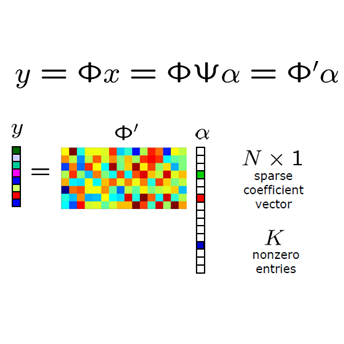We formulate a physics-informed compressed sensing (PICS) method for the reconstruction of velocity fields from noisy and sparse phase-contrast magnetic resonance signals. The method solves an inverse Navier-Stokes boundary value problem, which permits us to jointly reconstruct and segment the velocity field, and at the same time infer hidden quantities such as the hydrodynamic pressure and the wall shear stress. Using a Bayesian framework, we regularize the problem by introducing a priori information about the unknown parameters in the form of Gaussian random fields. This prior information is updated using the Navier-Stokes problem, an energy-based segmentation functional, and by requiring that the reconstruction is consistent with the $k$-space signals. We create an algorithm that solves this reconstruction problem, and test it for noisy and sparse $k$-space signals of the flow through a converging nozzle. We find that the method is capable of reconstructing and segmenting the velocity fields from sparsely-sampled (15% $k$-space coverage), low ($\sim$$10$) signal-to-noise ratio (SNR) signals, and that the reconstructed velocity field compares well with that derived from fully-sampled (100% $k$-space coverage) high ($>40$) SNR signals of the same flow.
翻译:我们从噪音和稀少的相向磁共振信号中,为重建速度场制定了一种物理知情的压缩感测方法(PICS ) 。 这种方法解决了一个反纳维埃- Stokes边界值问题, 使我们能够共同重建和分割速度场, 同时推断隐藏的数量, 如流体动力压力和壁剪裁压力。 我们使用一个巴耶斯框架, 通过引入以高山随机字段形式提供的关于未知参数的先验信息, 使问题正规化。 先前的信息通过纳维尔- 斯托克斯问题、 一种基于能源的分割功能以及要求重建与美元空间信号相一致。 我们创建了一种算法, 解决这一重建问题, 并测试流动中的噪音和稀疏的美元空间信号, 其形式为高采样( 美元- 空间覆盖)、 低美元- 10美元( 美元- 美元) 的信号- 空间覆盖率( S- missional- mission), 并用以100美元( S- main- main- main- silveildal) 的高度信号(S- main- main- main- sildal- mission- slation) 比例, 和完全重制成的SIS- mess- mess- mess- mess- mess- sildro) 。




